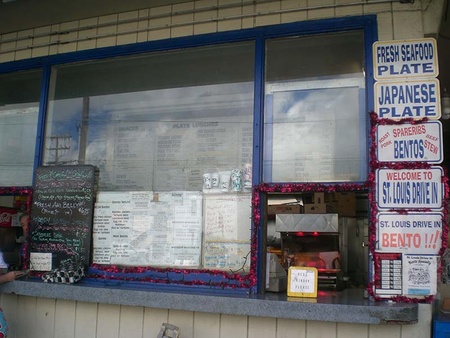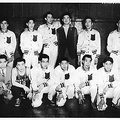Folks from Hawai‘i will tell you: plate lunch starts with two scoops rice and one scoop mac salad. Atop this starchy base, go ahead and pile on any protein-heavy fare you want, just don’t skimp on salt or grease. Glistening slices of beef teriyaki, crunchy chunks of chicken katsu, gristly chains of short rib, golden slabs of mahi mahi, viscous pools of sumptuous stew, fried heaps of hot dog, SPAM, or egg—it’s all game. If the mood strikes you, pour on a ladleful of brown gravy. Garnish with a little shredded cabbage, to add a touch of color and the illusion of nutritional value, and itadakimasu! You’re all set to enjoy an Island original.
Jokingly defined in the comic dictionary Pidgin to da Max as the “state food of Hawai‘i,” plate lunch can be ordered at hole-in-the-walls from Hilo to Honolulu. This ubiquitous and much-loved meal blends a host of different ethnic culinary traditions into one delicious mishmash that has been around far longer than more faddish fusion creations.
The humble beginnings of the plate lunch date back to the colonization of Hawai‘i, during the late 1800s, when foreign corporations were staging a gradual takeover of the indigenous people’s sovereign kingdom. Sugar production was turning into big business, and wage laborers from across the globe—China, Japan, Portugal, Norway, Germany, Korea, Puerto Rico, the Philippines, and Russia—converged on the Islands to work the fields and mills. Inevitably, “as laborers and their families mingled together on the plantations, they began to exchange and enjoy the different ethnic dishes of their friends and coworkers,” notes history scholar Ronald Takaki in Pau Hana: Plantation Life and Labor in Hawaii.
Bettty Shimabukuro, features editor at the Honolulu Star-Bulletin and co-author of What Hawaii Likes to Eat with Muriel Miura, concurs that “everything I’ve read about [plate lunch] traces the roots to plantation times and the bentos that the Japanese workers took into the fields. At mealtime there would be sharing between the different workers and eventually Filipino, Hawaiian, Chinese, and Korean dishes got mixed in with the Japanese.”
By 1900, Japanese people accounted for 40 percent of the Islands’ population—over 60,000 individuals in all, a number that would more than double in the next three decades. Naturally, this demographic trend had a profound influence on local eating habits. In fact, the Japanese American National Museum’s From Bento to Mixed Plate: Americans of Japanese Ancestry in Multicultural Hawai‘i suggests that the first person to serve plate lunch was Nikkei.
The book recounts the story of Moyo Iwamoto, who immigrated to Hawai‘i from Yamaguchi prefecture with her husband. When he died in 1921, she started selling snacks out of a pushcart along Honolulu Harbor to support their six children. After several years, she earned enough to lease a small commercial space on Channel Street, where “for 50 cents, hungry customers received an eight-inch paper plate loaded down with rice, kim chee, takuan, a vegetable, and a main entrée. Even as far back as those prewar days, they could choose from main dishes like beef stew, beef tomato, butterfish, chopped steak, pig’s feet, chicken long rice, pork chops, ‘mix lunch,’ ham hock, and saimin.”
Mouthwatering as it sounds, conspicuously absent from this menu is mac salad, so a stickler for detail might take issue with the idea that Iwamoto cooked up the inaugural plate lunch. When and where mac salad entered the picture, however, remains unclear. Ten years ago, the Star-Bulletin surveyed 30 food experts, researchers and proprietors to find the answer, but to no avail. “I don’t think anyone knows for sure,” says Shimabukuro.
“I never eat the mac salad,” she avows, mentioning that she tends to avoid plate lunch in general: “Not good for my continuing futile efforts to lose weight.”
Ryan Tatsumoto, who pens the Gochiso Gourmet food and wine column for the Nichi Bei Times, agrees that “the basic plate lunch is not conducive to a healthy lifestyle: lots of starch… lots of fat… and very low in fiber.” A clinical pharmacist who practices on Oahu, he adds, “I joke with patients that they can consume all the plate lunches they want—as long as they only eat the box that it comes in.”
Yet despite its nutritional downside, he confirms that this Island staple will stay popular even as society becomes increasingly health-conscious. Citing flavor and cost as basic reasons, he puts forth a metaphysical argument as well, asserting, “Plate lunches more than feed the body, they also feed the soul.” Tatsumoto explains this holds especially true for anyone who departs Hawai’i and out of nostalgia craves “that flavor that you grew up with.”
Take for instance Kurt Osaki, who lives in the San Francisco Bay Area but grew up on Kauai, where his grandparents owned a small okazuya (or Japanese deli) that offered plate lunch goodies. Feeling the tug of his heart and his stomach from afar, he and a couple friends from the Islands launched their own restaurant venture, Hukilau, in 2001. With locations now open in San Francisco, San Jose, and most recently Honolulu, the cofounder says, “We serve a glorified plate lunch” (i.e., the utensils aren’t disposable).
Referring back to the plantation roots of this meal, Osaki expresses a desire to keep on cross-breeding cuisines at his own establishment, pointing to the Hukilau’s Kalua Pork & Cheese Quesadilla as one example from the menu. Aware of other legacies passed down to him as well, the transplant makes sure to acknowledge those before him who strived to introduce Island flavors to the Mainland: “We give credit to Nikkei pioneers such the Takahashi family in San Mateo, who brought in and served Hawaiian food during the postwar era to accommodate the Hawaiian ex-pats living in the Bay Area, and the Hosoda family, who continue to support and distribute Hawaiian products along the West Coast.”
Thanks to the efforts of these individuals and countless others, plate lunch has gained serious traction not only in California, but further east as well. L&L Hawaiian Barbecue has led the charge with scores of franchises all across the U.S. in places as unexpected as Utah, Texas, and New York, while more and more independent ventures like Hukilau have been setting up shop and scooping out starch. And although dieticians may not see this as a particularly auspicious development, for Osaki the value of this movement has nothing to do with calorie counting.
“What makes a plate lunch special,” he says, “is that it is not connected to one culture, but is a diverse mix that creates a beautiful end-product that we all can enjoy—kind of a United Nations of food.” He goes so far as to add, “Maybe our leaders may learn something from the plate lunch in creating peace and harmony for future generations.”
Of course, President Barack Obama does already possess a fondness for it, having been born and raised on Oahu. As he told a crowd at a campaign event in Honolulu last August, “I’m going to get a plate lunch. I might go to Zippy’s. I might go to Rainbow Drive-In.” Yet although one might like to view this as somehow promising for the fate of the world, the idea that this food can inspire wide-spread, substantive change sounds a little far-fetched to say the least.
It’s the kind of cheerily optimistic thinking that several academics take aim at in Karen Ishizuka’s short documentary The Politics of Plate Lunch, which explores “the inter-ethnic and multi-generational complexities of contemporary Hawaii.” A number of the interviewees set out to debunk the notion that the Islands form an idyllic melting pot of cultural harmony as epitomized through the local fare.
But while employing simplistic metaphors might seem naive, Obama himself cautions that the opposite extreme, cynicism, can be counterproductive as well. To this end, then, it’s worth considering the rather hopeful words from activist and law professor Mari Matsuda that close out the film: “People who are vastly different from each other in background, living side by side and exchanging cultural values in a way that can be positive, is a part of the Hawai‘i experience—and it’s a good part. And I think it reflects a universal human ability and desire to learn from, appreciate, and know people who are different from themselves. And when I’m homesick for Hawai‘i, that’s what I’m homesick for.”
Perhaps all that’s missing here is two scoops rice and one scoop mac salad.
This article was originally published in Nikkei Heritage Vol. XX, No. 1 (Winter - Spring 2009), a journal of the National Japanese American Historical Society.
© 2009 National Japanese American Historical Society






